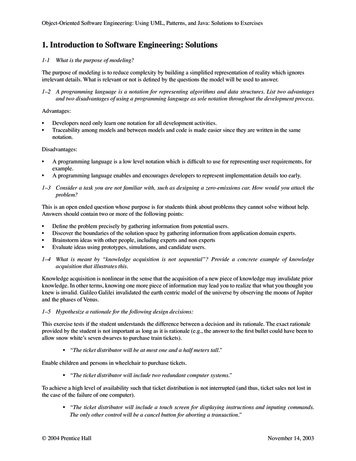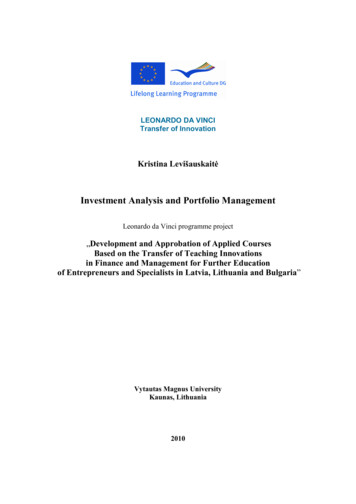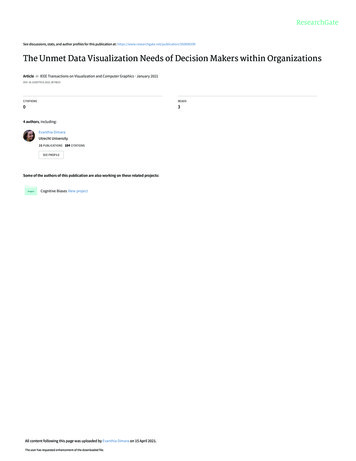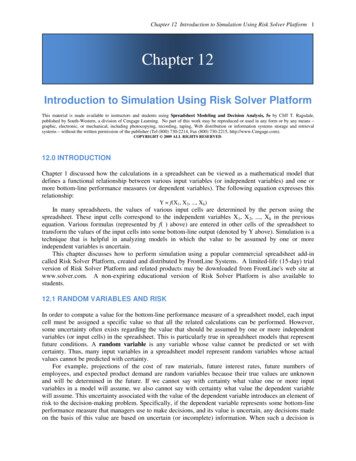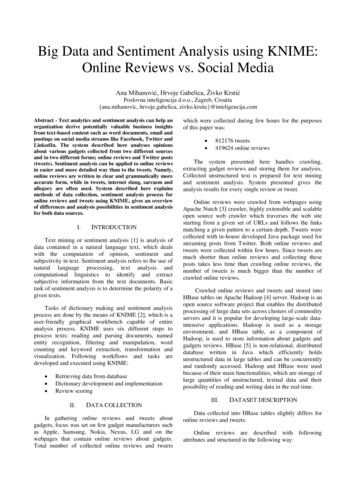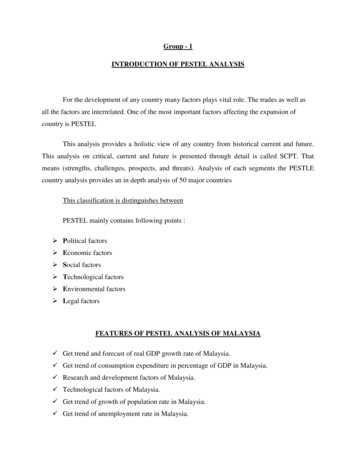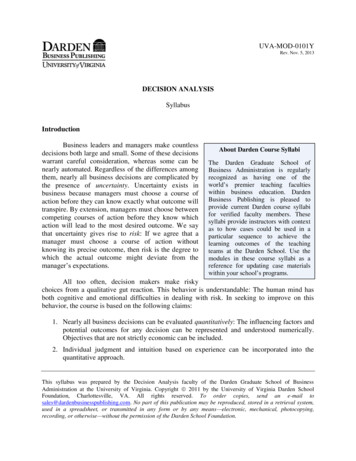
Transcription
UVA-MOD-0101YRev. Nov. 5, 2013DECISION ANALYSISSyllabusIntroductionBusiness leaders and managers make countlessdecisions both large and small. Some of these decisionswarrant careful consideration, whereas some can benearly automated. Regardless of the differences amongthem, nearly all business decisions are complicated bythe presence of uncertainty. Uncertainty exists inbusiness because managers must choose a course ofaction before they can know exactly what outcome willtranspire. By extension, managers must choose betweencompeting courses of action before they know whichaction will lead to the most desired outcome. We saythat uncertainty gives rise to risk: If we agree that amanager must choose a course of action withoutknowing its precise outcome, then risk is the degree towhich the actual outcome might deviate from themanager’s expectations.About Darden Course SyllabiThe Darden Graduate School ofBusiness Administration is regularlyrecognized as having one of theworld’s premier teaching facultieswithin business education. DardenBusiness Publishing is pleased toprovide current Darden course syllabifor verified faculty members. Thesesyllabi provide instructors with contextas to how cases could be used in aparticular sequence to achieve thelearning outcomes of the teachingteams at the Darden School. Use themodules in these course syllabi as areference for updating case materialswithin your school’s programs.All too often, decision makers make riskychoices from a qualitative gut reaction. This behavior is understandable: The human mind hasboth cognitive and emotional difficulties in dealing with risk. In seeking to improve on thisbehavior, the course is based on the following claims:1. Nearly all business decisions can be evaluated quantitatively: The influencing factors andpotential outcomes for any decision can be represented and understood numerically.Objectives that are not strictly economic can be included.2. Individual judgment and intuition based on experience can be incorporated into thequantitative approach.This syllabus was prepared by the Decision Analysis faculty of the Darden Graduate School of BusinessAdministration at the University of Virginia. Copyright 2011 by the University of Virginia Darden SchoolFoundation, Charlottesville, VA. All rights reserved. To order copies, send an e-mail tosales@dardenbusinesspublishing.com. No part of this publication may be reproduced, stored in a retrieval system,used in a spreadsheet, or transmitted in any form or by any means—electronic, mechanical, photocopying,recording, or otherwise—without the permission of the Darden School Foundation.
-2-UVA-MOD-0101Y3. Business people will achieve consistently better outcomes when they explicitlyincorporate risk into their decision making.Course DescriptionThis course highlights the analytical methods that decision makers use to gain insight intorisk and uncertainty to help students develop the skill and sophistication to artfully use them.Students will become better decision makers as they learn to proactively manage risk in creativeways.The course emphasizes the design of analyses to fit circumstances and interpretation ofresults; it does not emphasize the mastery of sophisticated mathematical techniques. It studiesand integrates individual judgment and personal intuition in realistic business situations with themost widely applicable methodologies of decision and risk analysis, probability and statistics,competitive analysis, and management science. The goal is always the quality of the decisionsmade in light of better analysis and deeper thinking, rather than simply the analysis itself.The first half of this course focuses more on a general framework for thinking about andmanaging risk. Students use the language of probability distributions to describe the uncertaintythey face and simulation as a tool to explore the impact of that uncertainty for the decisions theyface. Situations involving uncertain future cash-flow streams and the role of the timing of thosecash flows on the valuing of opportunities will be examined. The role data can play in shapingcalibration of future uncertainties, specifically touching on the use of parametric probabilitydistributions as a way to describe uncertainty, sampling as a source of data, and regression as atool to capture the relationship between uncertain quantities to produce better forecasts areconsidered. Students will also gain skill in spreadsheet modeling.The second half of the course builds on the first by focusing more on ways to proactivelymanage risk, particularly through identifying and/or creating opportunities to add value and/orreduce risk through the sequencing of decisions. Students will consider the value of acquiringadditional information before decisions have to be made, as well as the value of strategies toreduce (or eliminate) risk at the time of decision. Gaining experience with assessing uncertaintiesand forecasting probability distributions and learning ways to address competitive situations,where uncertainty includes not knowing how a competitor might behave, will be topics. Studentswill learn how to influence active competitors that are capable of anticipating their actions andresponding to them (in part, via analysis of matrix games). Finally, the use of linear constrainedoptimization models (and Excel Solver) to aid decisions with a large number of decisionvariables and constraints will be studied.
-3-UVA-MOD-0101YObjectives To develop a process for knowing when and how to do managerially relevant analysisunder conditions of uncertainty, many decision variables, and unstructured contexts,using both data and personal judgment. To develop a framework for understanding uncertainty, a language for describinguncertainty, and methodologies for making decisions in light of uncertainty, all throughfield-based case studies about practicing managers. To provide the basic skills and conceptual understanding of the most widely applicablemethodologies of decision and risk analysis, probability and statistics, competitiveanalysis, optimization, and management science.Course MaterialsThe cases and technical notes included in the course outline are required course materialsto be prepared prior to each class meeting. Some days, there will be an available electronicspreadsheet containing data from the case. There will be online learning modules occasionallymade available to students. These can be tutorials, software demonstrations, or computing tasks.Electronic items are linked from assignments or found in the online learning managementsystem.Detailed assignment questions suggest specific steps in preparing for class. These skillbuilding days are based on expository reading about methodology to be mastered in carrying outan analysis. Sometimes only the case is indicated with a single assignment question (or perhapsnone). This does not mean that no quantitative analysis is needed. Indeed, the task for studentsincludes diagnosing the situation and structuring an approach to the analysis from the case itselfas well as carrying out the analysis. Later, students will diagnose the problem and structure aframework for a decision key.A list of supplementary references follows. Since the course approaches topics from apragmatic, decision-oriented perspective, students should, in general, be wary of devoting toomuch time to reading text but use the better sources of help provided by a learning team orinstructor. Nonetheless, of the supplementary references, the first three are among the best. Bell, D. E. and A. Schleifer, Jr., Decision-Making Under Uncertainty (Cambridge, MA:Course Technology, Inc., 1995). Bodily, S. E., R. L. Carraway, S. C. Frey Jr., and P. E. Pfeifer, Quantitative BusinessAnalysis: Text and Cases (New York: Irwin McGraw-Hill, 1998). Brightman, H. J., Statistics in Plain English (Cincinnati, OH: South-Western PublishingCo., 1986).
-4-UVA-MOD-0101Y Clemen, R. T., Making Hard Decisions: An Introduction to Decision Analysis (Boston:PWS-Kent Publishing Company, 1991). Curwin, J. and R. Slater, Numeracy Skills for Business (London: Chapman & Hall, 1994). Eppen, G. D., F. J. Gould, and C. P. Schmidt, Introductory Management Science, 2nd ed.(Englewood Cliffs, NJ: Prentice-Hall, Inc., 1987). Freedman, D., R. Pisani, and R. Purves, Statistics (NY: W.W. Norton & Company, Inc.,1978). Hamburg, M., Statistical Analysis for Decision Making, 4th ed. (NY: Harcourt BraceJovanovich, Publishers, 1987). Holloway, C. A., Decision Making Under Uncertainty (Englewood Cliffs, NJ: PrenticeHall, Inc., 1979). Keeney, R. L., Value-Focused Thinking: A Path to Creative Decision-Making (HarvardUniversity Press, 1996). Kirkwood, C. W., Strategic Decision Making: Multi-Objective Decision Analysis withSpreadsheets (Belmont, CA: Duxbury Press, 1997). Lapin, L. L., Statistics for Modern Business Decisions, 2nd ed. (NY: Harcourt BraceJovanovich, Publishers, 1978). Plane, D. E., Management Science: A Spreadsheet Approach (Danvers, MA: Boyd &Fraser Publishing, 1994). Powell, S. G. and K. R. Baker, Management Science: The Art of Modeling withSpreadsheets, 2nd ed. (Hoboken, NJ: 2007). Ragsdale, C. T., Spreadsheet Modeling and Decision Analysis: A Practical Introductionto Management Science (Cambridge, MA: Course Technology, Inc., 1995). Rosenthal, J. S., Struck by Lightning: The Curious World of Probabilities (Washington,DC: Joseph Henry Press, 2006). Savage, S. L., The Flaw of Averages: Why We Underestimate Risk in the Face ofUncertainty (Hoboken, NJ: John Wiley & Sons, Inc., 2009).Prior to class, students should not discuss the case assigned to that class with anyone whohas sat through a previous (or simultaneous) class discussion of the case as side discussion andinformation impairs the pedagogical design of many classes and interferes with the learningprocess. Students are preparing for situations in which they will not have hindsight information,and they should get ready for them now.
-5-UVA-MOD-0101YDarden Course InstructorsDarden Teaching FacultyPhillip PfeiferYael Grushka-CockayneCasey LichtendahlSamuel BodilyCases by This AuthorPfeifer casesGrushka-Cockayne casesLichtendahl casesBodily casesCourse OutlineClassMaterialsIntroduction1“Reid’s Raisin Company (A)” (Dartmouth Tuck case)“Influence Diagram Exercises” (UVA-QA-0373)“Framework for Analyzing Risk” (UVA-MOD-0101)2“George’s T-Shirts” (UVA-QA-0346)“George’s T-Shirts Addendum” (UVA-QA-0548)3“George’s Revised Forecasts” (UVA-QA-0560)Probability Distributions: Ch. 11, QBA“PriceMax Forecasting Exercise” (UVA-QA-0748)Supplemental Spreadsheet Available.“Eliciting & Evaluating Expert Forecasts” (UVA-QA0734)5“Skanska USA Building” (UVA-QA-0735R)Supplemental Spreadsheet Available. Postclass learningmodule: Building Dhahran Spreadsheet“Evaluating Multiperiod Performance” (UVA-QA-0518)6“Appshop, Inc.” (UVA-QA-0618)“Quick Start Guide to Crystal Ball” (UVA-QA-0658)“Analyzing Uncertainty, Probability Distributions, andSimulation” (UVA-QA-0660)Learning Module: Crystal Ball Litigate Demo“Data and Distributions” (UVA-MOD-0102)7“Engine Services, Inc.” (UVA-QA-0663)Supplemental Spreadsheet Available.“A Brief Primer on Probability Distributions” (UVA-QA0517)8“Sprigg Lane (A)” (UVA-QA-0372)Supplemental Spreadsheet Available.9“Ponca City Cogeneration Plant” (UVA-QA-0469)“Ponca City Cogeneration Plant: Model Improvement andFinal Decision” (UVA-QA-0747)“Ponca City Cogeneration Plant Supplement” (UVA-QA0470)4TopicBuilding and Vetting Spreadsheets; Search forOptimal QuantityChoice and Expected Monetary ValueLanguage, Forecasting, and Use of ProbabilityDistributions for Discrete and ContinuousUncertaintiesComparing Forecasters, OverconfidenceMultiperiod Pro Forma and NPVSimulating NPVAnalytical Distribution from Data; Searchingfor a QuantityProbability Distributions and SpreadsheetModeling; RiskRisk Management
-6-UVA-MOD-0101YSupplemental Spreadsheet Available. Learning Module:Tornado Sensitivity10“Amore Frozen Foods (A) Macaroni and Cheese FillSample UncertaintyTargets” (UVA-QA-0317)Supplemental Spreadsheet Available.“Sampling” (UVA-QA-0513)“Regression” (UVA-MOD-0103)11“Hightower Department Stores: Imported Stuffed Animals Introduction to RegressionIntroduction to Least Squares” (UVA-QA-0268)Supplemental Spreadsheet Available.12“Edgcomb Metals (A)” (UVA-OM-0549)Multiple Regression and Dummy VariablesSupplemental Spreadsheet Available.13“Ballis’s Benchmark (A)” (UVA-F-1621)Data Filtering, Pivot Tables, and RegressionSupplemental Spreadsheet Available.“Ballis’s Benchmark (A) Supplement” (UVA-F-1623)14“The Oakland A’s (A)” (UVA-QA-0282)Regression ModelingThe Oakland A’s (A) Supplement“Linear Model-Building” (UVA-QA-0293)15“Lac Leman Festival de la Musique (A)”(UVA-QA-0707) Summary“Lac Leman Festival de lat Musique (B)” (UVA-QA0708)Supplemental Spreadsheet Available.“Decision Trees and Downstream Decisions” (UVA-MOD-0104)16“Freemark Abbey Winery” (HBSP case)Decision Tree Analysis, Value of InformationLearning Module: Building a Freemark Decision Tree with & Control, Risk AversionTreePlan17“Orion Controls (A)” (UVA-QA-0602)Downstream Decision18“Merck & Company: Product KL-798” (UVA-QA-0582) Decision Tree Analysis Practice19“Orion Controls (B)” (UVA-QA-0603)Downstream Decision with ContinuousUncertainties20“Chance Encounters II” (UVA-QA-0783)Real OptionsSupplemental Spreadsheet Available.“Strategic Interactive Decisions” (UVA-MOD-0105)21“Lesser Antilles Lines: The Island of San Huberto” (UVA- Matrix Game AnalysisQA-0355)Supplemental Spreadsheet and Link to Online CompetitionAvailable.“Structuring a Competitive Analysis: Decision Trees,Decision Forests, and Payoff Matrices” (UVA-QA-0674)“Competitor Analysis” (UVA-QA-0527)22“Germania Fluggesellschaft MBH (A)” (UVA-QA-0620) Structuring Competitive Analysis23“Kelly Solar” (UVA-F-1614)Negotiation Analysis24“Bidding for the Legacy Hotel” UVA-QA-0696)Bidding and AuctionsSupplemental Spreadsheet Available.25“Maxco, Inc., and t
16 “Freemark Abbey Winery” (HBSP case) Decision Tree Analysis, Value of Information Learning Module: Building a Freemark Decision Tree with & Control, Risk Aversion TreePlan 17 “Orion Controls (A)” (UVA-QA-0602) Downstream Decision 18 “Merck & Company: Product KL-798” (UVA-QA-0582) Decision Tree Analysis Practice
